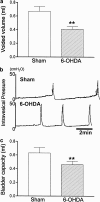Dopaminergic mechanisms underlying bladder hyperactivity in rats with a unilateral 6-hydroxydopamine (6-OHDA) lesion of the nigrostriatal pathway
- PMID: 12922929
- PMCID: PMC1573982
- DOI: 10.1038/sj.bjp.0705388
Dopaminergic mechanisms underlying bladder hyperactivity in rats with a unilateral 6-hydroxydopamine (6-OHDA) lesion of the nigrostriatal pathway
Abstract
1. This study was undertaken to elucidate dopaminergic mechanisms underlying bladder hyperactivity in a rat model of Parkinson's disease (PD) induced by a unilateral 6-OHDA injection into the substantia nigra pars compacta. 2. In 6-OHDA-lesioned rats, voided volume per micturition (0.41+/-0.04 ml, mean+/-s.e.m.) measured during 24 h in a metabolic cage was significantly smaller than in sham-operated rats (0.67+/-0.07 ml). 3. Cystrometrograms (CMG) in conscious animals revealed significantly smaller bladder capacity (BC) (0.46+/-0.03 ml) in 6-OHDA-lesioned rats than in sham rats (0.72+/-0.06 ml). 4. SKF38393 (D1/D5 receptor agonist, i.v.) significantly increased BC in 6-OHDA rats without apparent effects in sham rats. SKF38393 applied intracerebroventricularly (i.c.v.) under urethane anesthesia also increased BC in 6-OHDA-lesioned rats and by a smaller increment in sham rats. 5. In contrast, quinpirole (D2/D3/D4 receptor agonist, i.v.) significantly reduced BC in sham and 6-OHDA-lesioned rats. Intrathecal injection of quinpirole similarly reduced BC in sham and 6-OHDA-lesioned rats. 6. PD128907 (D(3)-receptor agonist) did not have significant effects on BC in 6-OHDA-lesioned rats. 7. These results indicate that a rat model of PD exhibited bladder hyperactivity as observed in patients with PD, and that stimulation of D1/D5 dopamine receptors at a supraspinal site can suppress bladder hyperactivity in PD, whereas stimulation of D2/D4, but not D3, dopamine receptors had the opposite effect to reduce bladder capacity. Thus, D1/D5 dopamine receptor agonists might be effective in treating neurogenic bladder hyperactivity in PD.
Figures









References
-
- ALBANESE A., JENNER P., MARSDEN C.D., STEPHENSON J.D. Bladder hyperreflexia induced in marmosets by 1-methyl-4-phenyl-1,2,3,6-tetrahydropyridine. Neurosci. Lett. 1988;87:46–50. - PubMed
-
- ARAKI I., KITAHARA M., OIDA T., KUNO S. Voiding dysfunction and Parkinson's disease: urodynamic abnormalities and urinary symptoms. J. Urol. 2000;164:1640–1643. - PubMed
-
- ARANDA B., CRAMER P. Effects of apomorphine and L-dopa on the parkinsonian bladder. Neurourol. Urodyn. 1993;12:203–209. - PubMed
-
- BAIK J.-H., PICETTI R., SAIARDI A., THIRIET G., DIERICH A., DEPAULIS A., LE MEUR M., BORRELLI E. Parkinson-like locomotor impairment in mice lacking dopamine D2 receptors. Nature. 1995;377:424–428. - PubMed
Publication types
MeSH terms
Substances
Grants and funding
LinkOut - more resources
Full Text Sources
Medical
Miscellaneous

